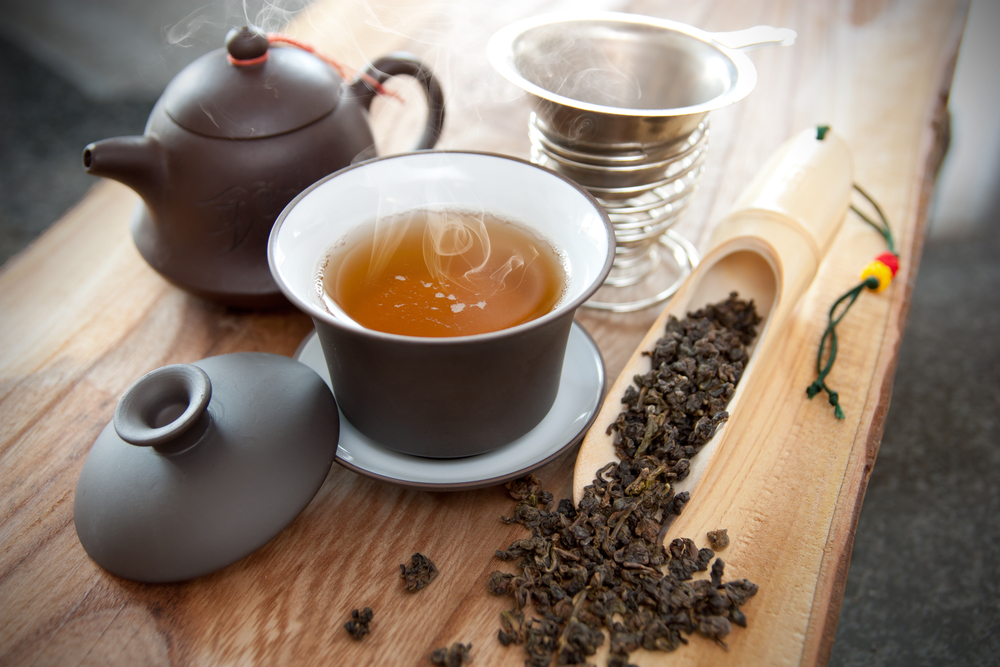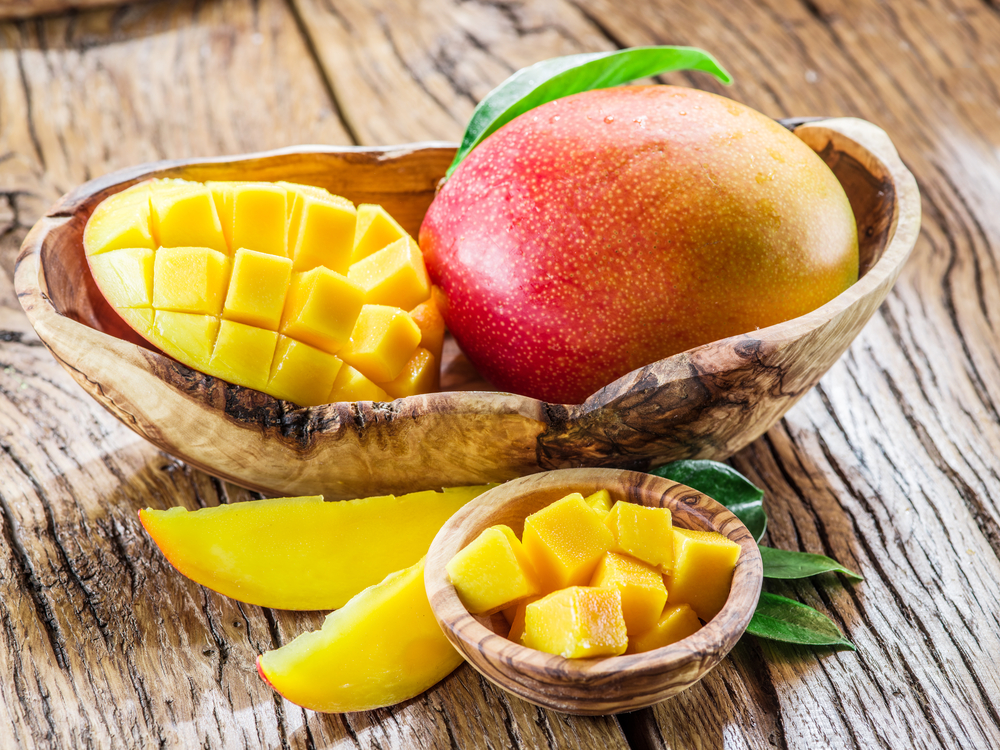Passion fruit is an exotic and unique fruit that is known for its distinctive taste and aroma. If you’re curious about what passion fruit tastes like, you’re not alone.
Many people are drawn to this fruit because of its intriguing name and appearance. In this article, I will provide you with a clear understanding of what passion fruit tastes like and how you can use it in your recipes.
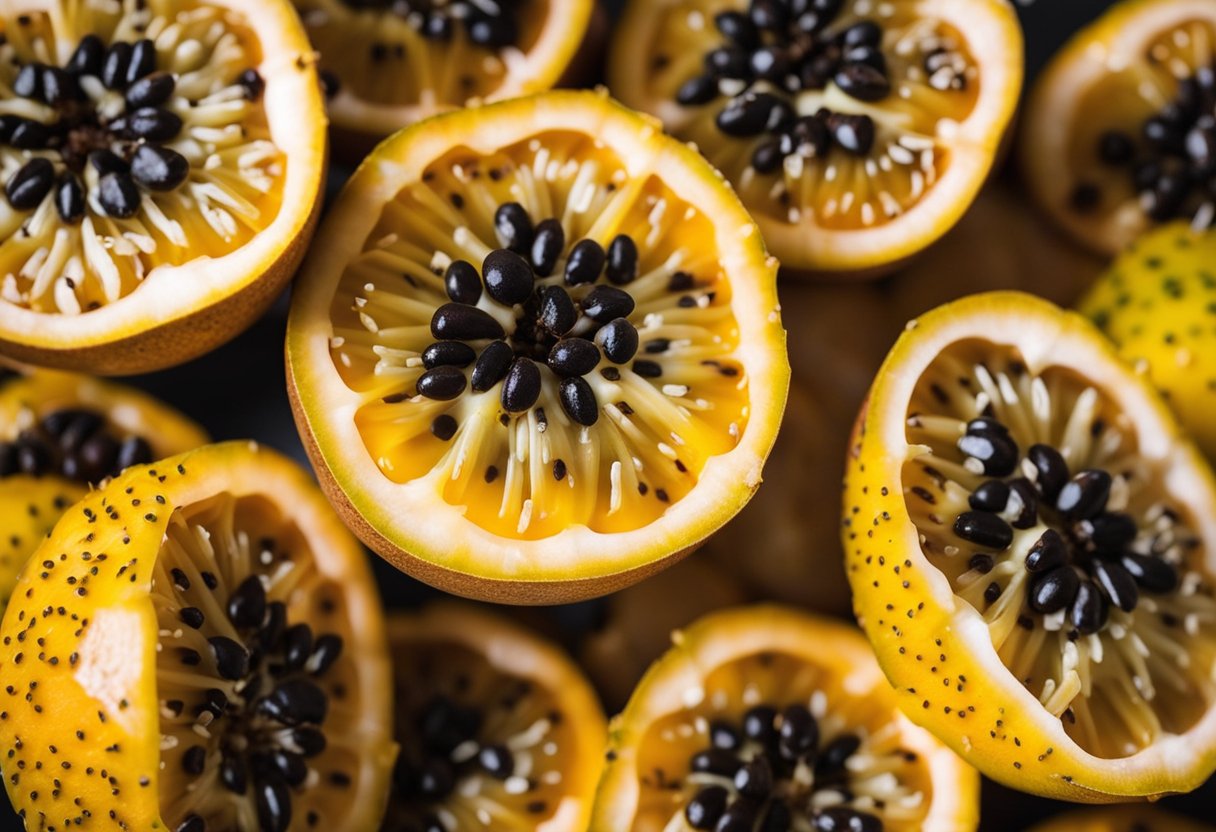
Understanding passion fruit is the first step to understanding its taste. Passion fruit is a tropical fruit that is native to South America, but it is now grown in many other parts of the world.
It has a tough outer shell that is purple or yellow in color, and inside, you will find a soft, juicy pulp that is filled with seeds. The pulp is the part of the fruit that is used in cooking and is what gives passion fruit its unique taste.
The taste of passion fruit is hard to describe, but it is often described as a combination of sweet and sour with a floral finish.
Some people compare it to pineapple or yellow kiwi, while others say it has notes of grapefruit, pear, and guava.
The taste can vary depending on the ripeness of the fruit, and some people prefer it when it is more wrinkly and ripe. Now that you have a basic understanding of what passion fruit tastes like, let’s explore how you can use it in your recipes.
Key Takeaways
- Passion fruit is an exotic and unique fruit that has a distinctive taste and aroma.
- The taste of passion fruit is a combination of sweet and sour with a floral finish, and it can vary depending on the ripeness of the fruit.
- Passion fruit can be used in a variety of recipes, including desserts, drinks, and sauces.
Understanding Passion Fruit
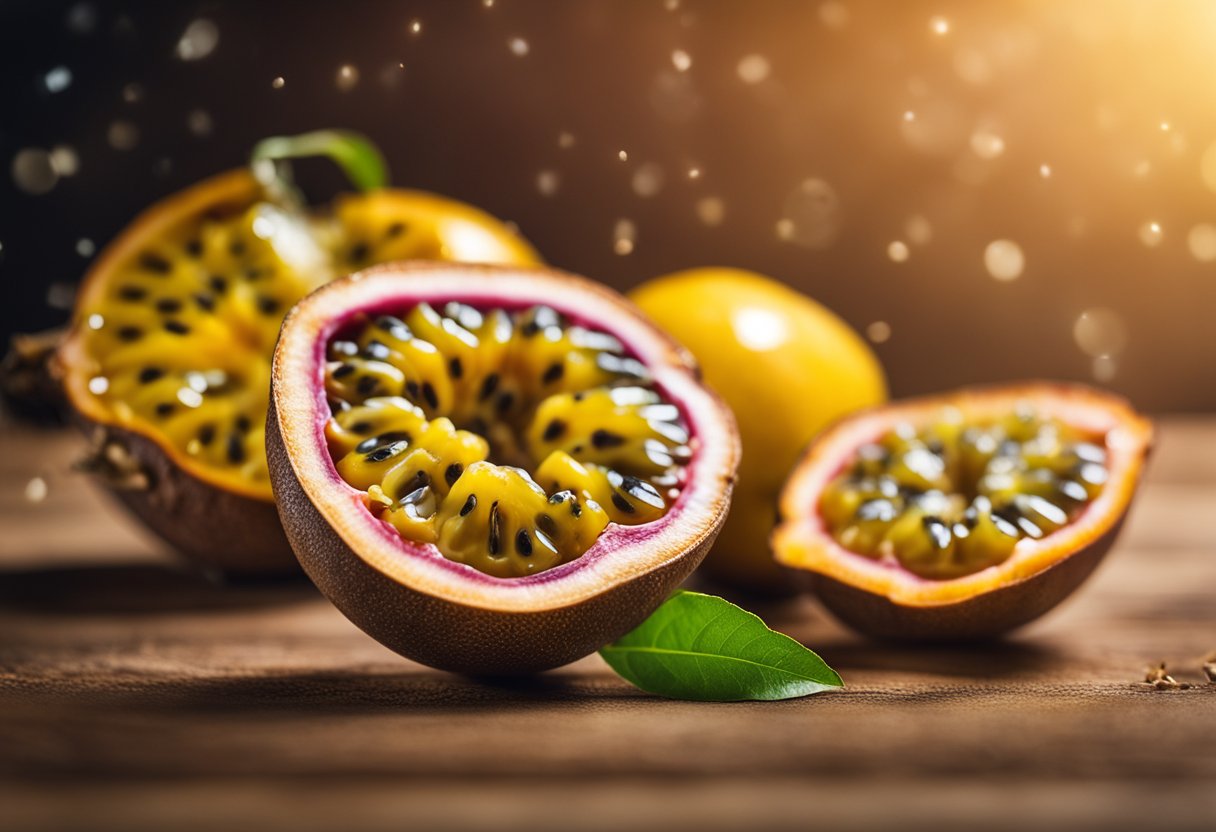
Passion fruit is a tropical fruit that is known for its unique and complex flavor. In this section, I will cover the different varieties of passion fruit, where it is grown, the anatomy of the fruit, how to store and ripen it, how to eat it, and its health benefits.
Varieties of Passion Fruit
There are two main varieties of passion fruit: Passiflora edulis and Passiflora flavicarpa. Passiflora edulis is the most commonly grown variety and is usually purple or yellow in color.
Passiflora flavicarpa, also known as the yellow passion fruit, is green when unripe and turns yellow when it is ripe.
Where is Passion Fruit Grown
Passion fruit is native to South America, but it is now grown in many tropical and subtropical regions around the world, including Brazil, Australia, Argentina, Hawaii, California, Paraguay, New Zealand, and India.
Anatomy of Passion Fruit
Passion fruit has a thick skin that is filled with small, crunchy seeds and orange-hued juice, which is the pulp of the fruit.
The seeds are edible and add a crunchy texture to the fruit. The pulp is the part of the fruit that is eaten and has a tangy, sweet, and slightly floral flavor.
Storing and Ripening
Passion fruit should be stored at room temperature until it is ripe. Once it is ripe, it can be stored in the refrigerator for up to a week or in the freezer for up to six months.
To ripen passion fruit, leave it at room temperature until it is soft to the touch.
How to Eat Passion Fruit
To eat passion fruit, cut it in half with a sharp knife and scoop out the pulp with a spoon. The skin is not edible and should be discarded.
Passion fruit can also be used in a variety of recipes, including smoothies, desserts, and cocktails.
Health Benefits of Passion Fruit
Passion fruit is a good source of antioxidants, fiber, and vitamins. It has been shown to improve digestion, boost the immune system, and reduce inflammation in the body.
Additionally, passion fruit is low in calories and can be a healthy addition to any diet.
The Taste of Passion Fruit
Passion fruit is a tropical fruit that has a unique flavor that can be described as a delightful mix of sweet, tart, and slightly tangy flavors.
In this section, I will describe the taste and texture of passion fruit and compare it to other fruits.
Describing the Flavor
The flavor of passion fruit is complex and can be challenging to describe. The taste is sweet, tart, and slightly sour, with a tangy aftertaste.
The sweetness of the fruit is not overpowering and is balanced nicely with the tartness. The pulp of the fruit is soft and gelatinous, and the seeds are crunchy, adding texture to the fruit.
Many people compare the taste of passion fruit to a blend of citrus fruits like oranges, lemons, and limes, combined with a hint of tropical sweetness. The fruit has a unique and exotic taste that is hard to find in other fruits.
Texture of Passion Fruit
The texture of passion fruit is unique and may take some getting used to. The fruit has a wrinkled, tough, and thick skin that encases the soft pulp and crunchy seeds inside.
The pulp of the fruit is gelatinous and has a texture similar to that of a grapefruit or kiwi. The seeds are crunchy and add texture to the fruit.
Comparing to Other Fruits
Passion fruit has a taste that is hard to compare to other fruits. However, some people describe the taste as a combination of pineapple, plum, grapefruit, kiwi, and mango.
The fruit has a sweet and tangy taste similar to a papaya but with a more complex flavor.
In conclusion, Passion fruit has a unique and exotic taste that is both sweet and tart. The texture of the fruit is soft and gelatinous, with crunchy seeds that add texture.
The taste of passion fruit is hard to compare to other fruits, but it can be described as a mix of citrus fruits with a hint of tropical sweetness.
Using Passion Fruit in Recipes
Passion fruit is a versatile fruit that can be used in a variety of recipes. Its unique sweet and tart flavor makes it an excellent ingredient in both sweet and savory dishes.
Here are some ways to use passion fruit in your recipes:
Passion Fruit in Drinks
Passion fruit is a great addition to drinks, especially cocktails and smoothies. To make a passion fruit cocktail, mix passion fruit juice with your favorite liquor, such as vodka or rum, and add a splash of soda water.
For a non-alcoholic option, mix passion fruit juice with sparkling water and a little bit of sugar to taste. Passion fruit smoothies are also delicious and easy to make.
Blend frozen passion fruit pulp with water or milk and add honey or sugar to taste.
Passion Fruit in Desserts
Passion fruit is a popular ingredient in desserts, especially in cakes, tarts, and mousses. Its tangy flavor pairs well with sweet cream and sugar.
To make a passion fruit cake, mix passion fruit juice with cake batter and bake as usual. You can also make a passion fruit cream by mixing passion fruit juice with whipped cream and sugar.
For a refreshing dessert, mix passion fruit juice with yogurt and freeze to make passion fruit frozen yogurt.
Cooking with Passion Fruit
Passion fruit can also be used in savory dishes, such as chicken and salad dressings. To make a passion fruit chicken, marinate chicken breasts in a mixture of passion fruit juice, olive oil, and garlic for at least an hour before cooking.
For a tangy salad dressing, mix passion fruit juice with olive oil, vinegar, and a little bit of sugar to taste.
When cooking with passion fruit, it’s important to use ripe fruit for the best flavor. Ripe passion fruit will have a wrinkled skin and will feel slightly soft to the touch.
You can also freeze passion fruit pulp for later use. To freeze passion fruit pulp, scoop the pulp out of the fruit and place it in an airtight container. Freeze for up to three months.
Overall, passion fruit is a delicious and versatile ingredient that can be used in a variety of recipes. Its unique flavor adds a tropical twist to any dish.
Passion Fruit Products
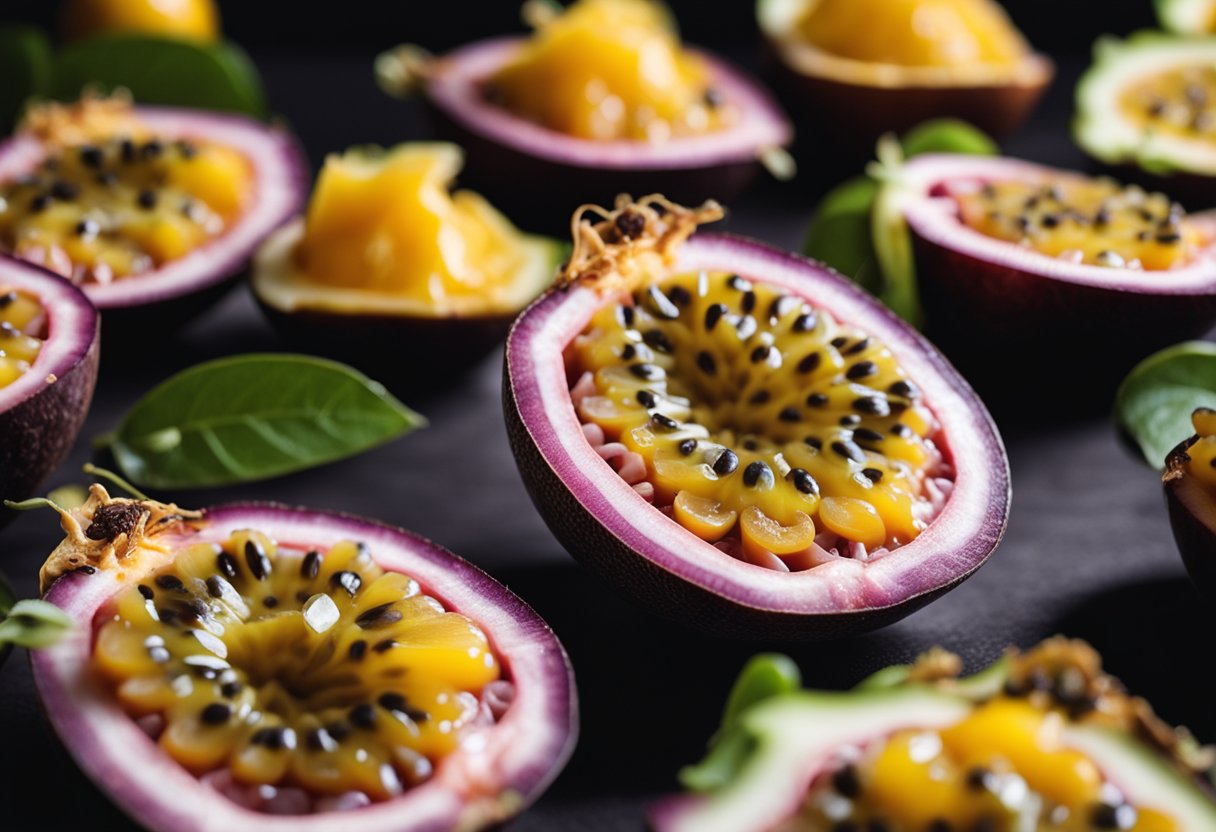
Passion fruit is a versatile fruit that can be used in a variety of products. Here are two popular passion fruit products that you can try:
Passion Fruit Puree
Passion fruit puree is a great ingredient to have on hand if you want to add a tropical twist to your recipes. It’s made by blending the pulp and seeds of ripe passion fruit until it’s smooth.
The puree is a bright green color and has a tangy, sweet flavor that’s perfect for making desserts, drinks, and sauces.
To make passion fruit puree, you’ll need a blender and some ripe passion fruit. Cut the passion fruit in half and scoop out the pulp and seeds into the blender.
Blend the mixture until it’s smooth, then strain it through a fine mesh sieve to remove any large pieces of seeds. The puree can be stored in the refrigerator for up to a week, or frozen for longer storage.
Passion fruit puree is a great addition to smoothies, cocktails, and desserts like cheesecake, ice cream, and mousse. It can also be used as a sauce for grilled meats or as a marinade for chicken or fish.
Passion Fruit Jam
Passion fruit jam is a delicious spread that can be enjoyed on toast, biscuits, or scones. It’s made by cooking down ripe passion fruit with sugar and lemon juice until it thickens into a spreadable consistency.
The jam has a bright orange color and a tangy, sweet flavor that’s perfect for breakfast or as a snack.
To make passion fruit jam, you’ll need ripe passion fruit, sugar, and lemon juice. Cut the passion fruit in half and scoop out the pulp and seeds into a saucepan.
Add the sugar and lemon juice to the pan and bring the mixture to a boil over medium heat. Reduce the heat and let the mixture simmer for about 30 minutes, stirring occasionally, until it thickens into a jam-like consistency.
Pour the jam into sterilized jars and let it cool before storing in the refrigerator.
Passion fruit jam is a great addition to a cheese board, and can also be used as a glaze for meats or as a topping for yogurt or ice cream. It’s a delicious way to enjoy the tropical flavor of passion fruit.
Frequently Asked Questions
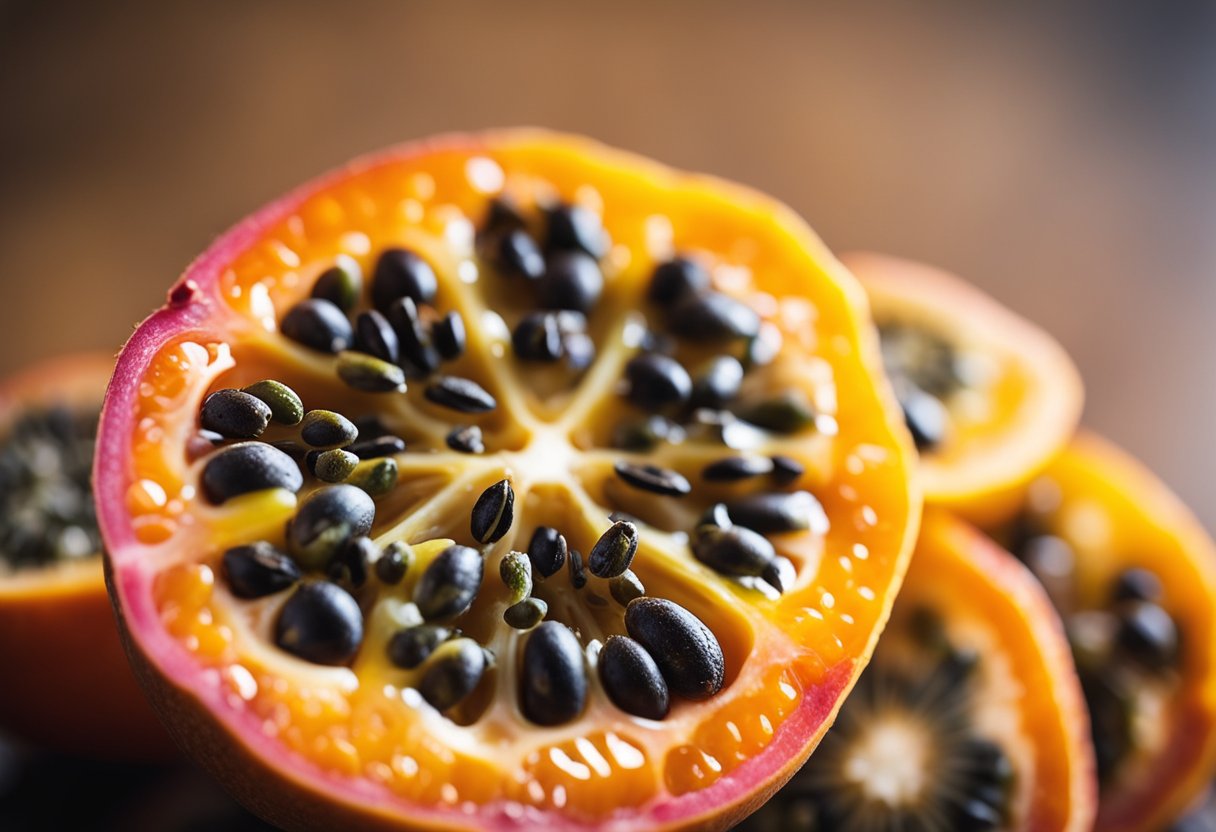
What are the health benefits of passion fruit?
Passion fruit is a good source of vitamins A and C, as well as dietary fiber. It is also rich in antioxidants, which can help protect the body against damage caused by free radicals.
Some studies have suggested that passion fruit may have anti-inflammatory properties and could help lower blood pressure.
How would you describe the flavor of passion fruit?
Passion fruit has a unique and complex flavor that is difficult to describe. Some people say it tastes sweet and tart, while others describe it as slightly sour or citrusy.
The fruit’s aroma is also distinctive, with hints of tropical fruit and floral notes.
What are some popular recipes that use passion fruit?
Passion fruit is a versatile ingredient that can be used in a variety of recipes, from desserts to cocktails. Some popular recipes that use passion fruit include passion fruit mousse, passion fruit sorbet, and passion fruit margaritas.
Where can I buy passion fruit seeds?
Passion fruit seeds can be found in many health food stores and online retailers. They are often sold in bulk or in small packets, and can be used to add flavor and texture to a variety of dishes.
Is passion fruit sour or sweet?
Passion fruit has a unique flavor that is both sweet and tart. The fruit’s pulp is sweet and juicy, while the seeds are crunchy and slightly sour.
Do you chew or swallow passion fruit seeds?
Passion fruit seeds are edible and can be chewed or swallowed. Some people prefer to remove them before eating the fruit, while others enjoy the added texture and flavor they provide.




